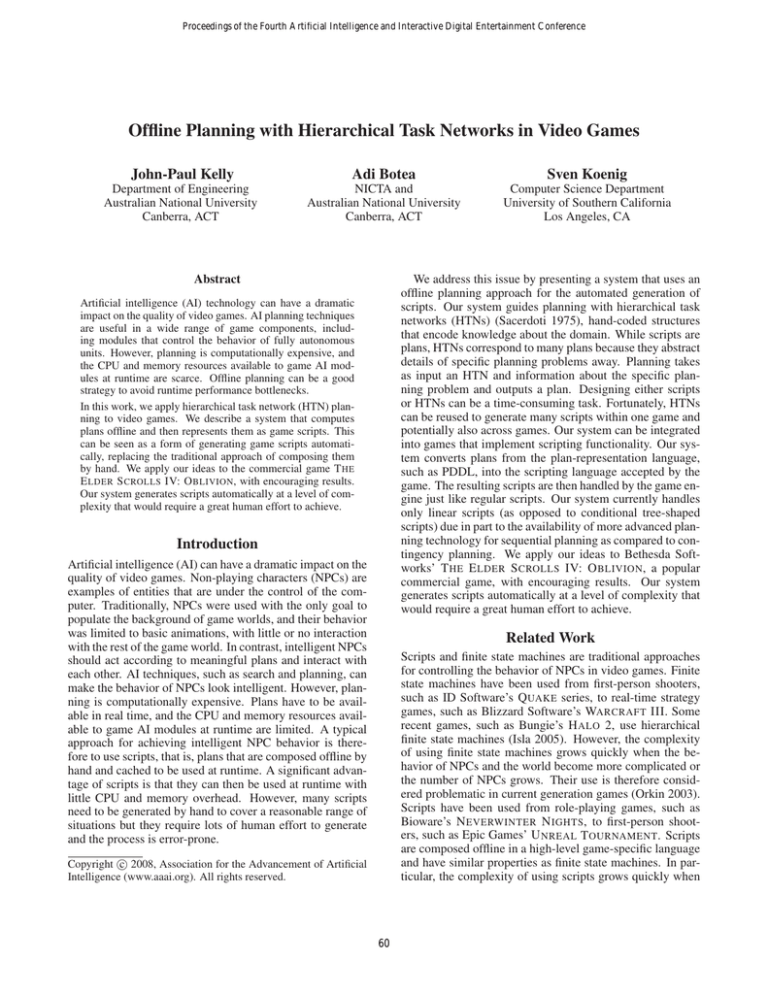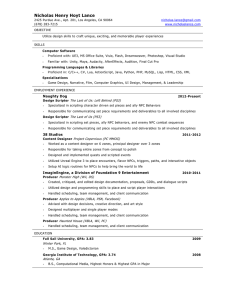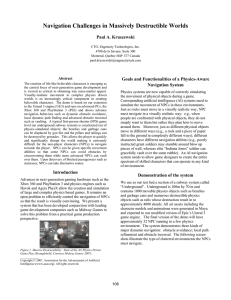
Proceedings of the Fourth Artificial Intelligence and Interactive Digital Entertainment Conference
Offline Planning with Hierarchical Task Networks in Video Games
John-Paul Kelly
Adi Botea
Sven Koenig
Department of Engineering
Australian National University
Canberra, ACT
NICTA and
Australian National University
Canberra, ACT
Computer Science Department
University of Southern California
Los Angeles, CA
Abstract
We address this issue by presenting a system that uses an
offline planning approach for the automated generation of
scripts. Our system guides planning with hierarchical task
networks (HTNs) (Sacerdoti 1975), hand-coded structures
that encode knowledge about the domain. While scripts are
plans, HTNs correspond to many plans because they abstract
details of specific planning problems away. Planning takes
as input an HTN and information about the specific planning problem and outputs a plan. Designing either scripts
or HTNs can be a time-consuming task. Fortunately, HTNs
can be reused to generate many scripts within one game and
potentially also across games. Our system can be integrated
into games that implement scripting functionality. Our system converts plans from the plan-representation language,
such as PDDL, into the scripting language accepted by the
game. The resulting scripts are then handled by the game engine just like regular scripts. Our system currently handles
only linear scripts (as opposed to conditional tree-shaped
scripts) due in part to the availability of more advanced planning technology for sequential planning as compared to contingency planning. We apply our ideas to Bethesda Softworks’ T HE E LDER S CROLLS IV: O BLIVION, a popular
commercial game, with encouraging results. Our system
generates scripts automatically at a level of complexity that
would require a great human effort to achieve.
Artificial intelligence (AI) technology can have a dramatic
impact on the quality of video games. AI planning techniques
are useful in a wide range of game components, including modules that control the behavior of fully autonomous
units. However, planning is computationally expensive, and
the CPU and memory resources available to game AI modules at runtime are scarce. Offline planning can be a good
strategy to avoid runtime performance bottlenecks.
In this work, we apply hierarchical task network (HTN) planning to video games. We describe a system that computes
plans offline and then represents them as game scripts. This
can be seen as a form of generating game scripts automatically, replacing the traditional approach of composing them
by hand. We apply our ideas to the commercial game T HE
E LDER S CROLLS IV: O BLIVION, with encouraging results.
Our system generates scripts automatically at a level of complexity that would require a great human effort to achieve.
Introduction
Artificial intelligence (AI) can have a dramatic impact on the
quality of video games. Non-playing characters (NPCs) are
examples of entities that are under the control of the computer. Traditionally, NPCs were used with the only goal to
populate the background of game worlds, and their behavior
was limited to basic animations, with little or no interaction
with the rest of the game world. In contrast, intelligent NPCs
should act according to meaningful plans and interact with
each other. AI techniques, such as search and planning, can
make the behavior of NPCs look intelligent. However, planning is computationally expensive. Plans have to be available in real time, and the CPU and memory resources available to game AI modules at runtime are limited. A typical
approach for achieving intelligent NPC behavior is therefore to use scripts, that is, plans that are composed offline by
hand and cached to be used at runtime. A significant advantage of scripts is that they can then be used at runtime with
little CPU and memory overhead. However, many scripts
need to be generated by hand to cover a reasonable range of
situations but they require lots of human effort to generate
and the process is error-prone.
Related Work
Scripts and finite state machines are traditional approaches
for controlling the behavior of NPCs in video games. Finite
state machines have been used from first-person shooters,
such as ID Software’s Q UAKE series, to real-time strategy
games, such as Blizzard Software’s WARCRAFT III. Some
recent games, such as Bungie’s H ALO 2, use hierarchical
finite state machines (Isla 2005). However, the complexity
of using finite state machines grows quickly when the behavior of NPCs and the world become more complicated or
the number of NPCs grows. Their use is therefore considered problematic in current generation games (Orkin 2003).
Scripts have been used from role-playing games, such as
Bioware’s N EVERWINTER N IGHTS, to first-person shooters, such as Epic Games’ U NREAL T OURNAMENT. Scripts
are composed offline in a high-level game-specific language
and have similar properties as finite state machines. In particular, the complexity of using scripts grows quickly when
c 2008, Association for the Advancement of Artificial
Copyright Intelligence (www.aaai.org). All rights reserved.
60
ages and a script. AI packages implement atomic behavior,
such as eating, working and sleeping, and have activation
preconditions that can include time ranges. For example, a
sleep package could be active from 10pm to 8am. Setting
the activation preconditions of appropriate AI packages corresponds to manual planning and does not require scripts,
which are repeatedly executed in a loop and mostly used for
dialogue and quest-related activities.
the behavior of NPCs and the world become more complicated or the number of NPCs grows, which makes it attractive to generate them semi-automatically. S CRIPT E ASE, for
example, aims at simplifying the process of writing scripts
through pattern templates (McNaughton et al. 2004). It allows game developers to create relatively complicated behavior via a graphical user interface (GUI), without having
to program them explicitly. The game developers must still
manually choose for each NPC which behavior to initiate
and when to initiate them, which means that the complexity
of using S CRIPT E ASE still grows quickly when the behavior of NPCs and the world become more complicated or the
number of NPCs grows.
AI planning techniques have recently been used in games
to control NPC opponents in first-person shooters, such
as Epic Games’ U NREAL T OURNAMENT or Monolith’s
F.E.A.R. Simple behavior (which does not need planning)
was acceptable in early games, such as moving between
ammunition caches and chasing all encountered opponents.
More complicated behavior (which needs planning) is expected in modern games, such as moving as coordinated
squads and performing tactics (including flanking or sending for backup) (Orkin 2006). While on-line planning might
be able to handle dynamic environments better than off-line
planning, it suffers from the problem that planning is computationally expensive. Plans have to be available in real
time, and the CPU and memory resources available to game
AI modules at runtime are limited. Off-line planning generates plans off-line and then uses them at runtime with little
CPU and memory overhead. It is easier to implement than
online planning and requires no changes to the game software. Off-line plans are typically generated by hand and
then represented as game scripts. For example, an NPC
might go every day for lunch at 12pm and then work until
4pm, resulting in realistic behavior. However, many scripts
need to be generated by hand to cover a reasonable range
of situations, they require lots of human effort to generate, the process is error-prone, and it is difficult to integrate
new NPCs into a game. For example, if an NPC needs
to buy merchandise from a store, then the NPC owner of
the store needs to be there. Thus, game designers need to
study the scripts for all NPCs to make sure that a change
does not cause conflicts. The complexity of manual planning therefore grows quickly when the behavior of NPCs
and the world become more complicated or the number of
NPCs grows. We address this issue in the following by describing a system that uses SHOP2 (Nau et al. 2003), a modern HTN planner, to automatically compute plans offline and
then represents them as game scripts. HTN planners were
devised in the 1970s (Sacerdoti 1975) and have been advocated as knowledge-based planning approach for complex
applications (Wilkins and desJardins 2001), such as production line scheduling (Wilkins 1988) and the game of bridge
(Smith et al. 1998).
Our System
In our system, the game developers design an HTN that encodes knowledge of the game world, create a set of AI packages for all actions of the HTN, and specify several planning
problems together with their initial world states. Each planning problem addresses the daily planning objectives of all
NPCs. The planner is run on each planning problem. It takes
as input the HTN, the initial world state and the planning
problem and outputs a plan for all NPCs. The planner cannot plan for each NPC separately since NPCs can interact.
The script generator converts the plan, whose actions correspond to AI packages, into a script for each NPC. Thus,
we extend the use of scripts to encode daily plans of NPCs.
The resulting scripts are then handled by the game engine
just like regular scripts. We now describe the various components in turn.
The Hierarchical Task Network
The planning problem is encoded as an abstract task in HTN
planning. Plans are action sequences that are refinements of
the abstract task. HTN methods encode how abstract tasks
(ovals) can be repeatedly refined into subtasks and eventually into actions (rectangles). When an abstract task is refined, the available methods are tried from left to right until
a method is found whose preconditions match the current
world state. A world state contains information such as a
list of all locations, a list of all stores, a list of items traded
in each store, the owner of each store, the number of deer
that populate the game, and the NPC state of each NPC. An
NPC state contains information such as the wealth, hunger
and tiredness level of the NPC, its current activity and location, its inventory, its house, and a list of actions that it can
perform.
Part of our HTN for T HE E LDER S CROLLS IV: O BLIVION is illustrated in Figure 1. It encodes plans for a game
day, divided into 24 game hours. If desired, plans that cover
several game days can be obtained by chaining plans together that correspond to one game day each, by enforcing
that the final world state of a plan is equal to the initial world
state of the next plan. The picture on top illustrates four alternative methods that refine the abstract task of spending
one game hour. If the preconditions of the first three methods are not satisfied, then an action is chosen at random, to
avoid NPCs being idle. The picture at the bottom illustrates
four alternative methods that refine the abstract task of obtaining food, namely directly by hunting or shopping or indirectly by learning how to hunt or making money, which will
help one to obtain food in the future. The precondition of
shopping is that the shop is open. After the NPC has waited
Our Testbed
We use Bethesda Softworks’ T HE E LDER S CROLLS IV:
O BLIVION, a role-playing game, as testbed for our system.
In this game, each NPC can be assigned a set of AI pack-
61
(cost food 5.0)
(cost skins -4.0)
(cost goods -50.0)
(cost learn-hunt 30.0)
(cost rent 1.0)
(shop skin-shop skins Stan)
(shop skin-shop goods Stan)
(shop food-shop food Fred)
(place Bobs-house)
(place forest)
(place skin-shop)
(place food-shop)
(deer 4.0)
(asleep Bob)
(money Bob 7.0)
(hungry Bob 7.0)
(sleepy Bob 4.0)
(have-goods Bob)
(at Bob Bobs-house)
(lives Bob Bobs-house)
(available-task Bob purchase-food sedate-hunger)
(available-task Bob wander wander)
(available-task Bob skin get-money)
(available-task Bob sleep sleep)
(available-task Bob sell-goods get-money)
Figure 2: Part of the initial world state.
Figure 1: Part of the HTN.
(!sleep Bob)
(!increment-person Bob)
(!wake Bob)
(!move Bob food-shop)
(!wait Bob food-shop)
(!increment-person Bob)
(!transaction Fred Bob Food)
(!eat Bob)
(!increment-person Bob)
(!move Bob forest)
(!skin Bob)
(!move Bob skin-shop)
(!transaction Stan Bob Skins)
for a sufficiently long time at the store, the precondition is
considered to be unsatisfied and the next method is tried.
The Planner
We use JSHOP2 (Nau et al. 2003), an off-the-shelf Java
implementation of SHOP2 that is publicly available and can
handle numerical variables, which is important to model aspects of world states such as hunger levels.
The Script Generator
The script generator converts the linear plans (action sequences) from the plan-representation language PDDL into
the scripting language used by T HE E LDER S CROLLS IV:
O BLIVION. Scripts check that the initial world state of
a game day matches the initial world state of their plan.
Scripts activate AI packages to implement actions. The AI
packages thus have no preconditions. Each script uses conditional statements to ensure that the actions of the NPC are
performed to completion, in the correct game hour and in the
correct order since the game repeatedly executes each script
in a loop. These conditional statements use variables that
keep track of the number of actions performed during the
current game hour as well as the last game hour that had all
of its actions completed. Each script uses flag-based message passing to encode the exchanges of goods that occur
between NPCs. The script of an NPC sends a request message to the script of another NPC to start an exchange. The
script of the second NPC performs its part of the transaction
and then sends a confirmation message. The script of the
first NPC then performs its part of the transaction.
Figure 3: Part of a plan.
if (theTime >= 10 && theTime < 11 && finished != 10)
if current == 0
AddScriptPackage TravelDeerForest
set current to current + 1
if current == 1
if bobVar != 60
set bobVar to 60
set skinning to 1
set skinDeer to 0
AddScriptPackage Skin
if current == 2
AddScriptPackage TravelSkinShop
set current to current + 1
if current == 3
if bobVar != 70
set bobVar to 70
set selling-skin to 1
AddScriptPackage SellSkins
if current == 4
set current to 0
set finished to 10
set bobVar to 0
Example
We use a small example with three NPCs named Bob, Stan
and Fred to illustrate parts of our system. Stan and Fred own
one store each and thus interact with Bob via the exchanges
of goods. For simplicity, we focus our attention on Bob for
a few game hours and do not present all details.
Figure 4: Part of a script.
62
Discussion
across games, similar to current graphics engines, networking code or physics simulators.
Second, offline automated planning has advantages over
online automated planning. We have already argued that
online planning is computationally expensive, and the CPU
and memory resources available to game AI modules at runtime are scarce because sophisticated graphics and sound algorithms need them. Offline planning avoids this overhead
and thus allows our system to compute more complex plans,
which cover longer game periods and have more interactions
between NPCs. Offline planning is less versatile than online
planning since offline plans need to account for many contingencies and could thus be both difficult to compute and
of large size in game worlds with incomplete or uncertain
information (such as dynamic or partially observable domains). In contrast, online planning can make assumptions
and replan when the current plan can no longer be executed.
Our game world, however, can be modeled as completely
observable and static by giving up only a small amount of
realism, since the human player is the only unknown. For
example, one can put virtual laws in place that prevent the
human player from interfering with the NPCs to make their
plans unexecutable, for example, by preventing the human
player from killing NPCs that are vital for plan execution.
Thus, offline planning is often sufficiently powerful, which
is one of the main reasons why scripting, a form of offline
planning traditionally performed by hand, is so popular in
modern games.
Third, interfacing an offline automated planner via a
scripting interface to a game has advantages. We have already argued that this makes offline planning easier to integrate into games than online planning since it requires no
changes to the game software. This is an important issue
in an industry with tight deadlines, where game companies
tend to ignore new ideas unless they can easily be added to
the game currently under development (Hopson 2006).
We now discuss the advantages and disadvantages of our
system.
First, automated planning has advantages over manual
planning. We have already argued that the complexity of
manual planning grows quickly when the behavior of NPCs
and the world become more complicated or the number of
NPCs grows. Automated planning increases the game development speed and thus allows our system to compute more
complex plans, which cover longer game periods and have
more interactions between NPCs, resulting in a better gaming experience. Automated planning requires game developers to encode knowledge of the game worlds, in our case in
form of HTNs. This should not be a problem for game developers since HTNs are similar to scripts. It is an open question whether game users, a community which is very large
and heterogeneous in terms of programming skills, would
welcome our system to add user-created content to off-theshelf games. Scripting has gotten end users accustomed to
using structured languages, and HTNs are not harder to understand than current sophisticated forms of scripts, such as
conditional scripts. If desired, GUIs could be designed to
help game developers and end users generate HTNs. Eventually, a standardized system similar to ours might get used
Comparison with S CRIPT E ASE
To the best of our knowledge, the work on S CRIPT E ASE
(McNaughton et al. 2004) is the only research on automating script generation previously reported in the games literature. S CRIPT E ASE is a tool that allows a user to generate scripting code through a graphical front end. Scripting can be performed even by users with no programming
skills. The process is faster and safer, since manual coding
introduces bugs that can be hard to fix.
As an important difference from our work, S CRIPT E ASE
makes no attempt at automating the planning side of scripting. The user is responsible to select all actions that compose a script, possibly starting from a predefined pattern.
Arguably, S CRIPT E ASE could be seen as focused on the
software engineering side of scripting rather than the AI
side. The authors state that AI capabilities, such as learning, would be a good addition to the S CRIPT E ASE tool (McNaughton et al. 2004). In addition, we believe that our work
and S CRIPT E ASE can be combined into a tool that would
provide access to a planning engine through a sophisticated
and intuitive GUI that would not require users to have deep
planning knowledge. The GUI and all the machinery behind
Figure 2 shows part of the initial world state but skips the
NPC states of Fred and Stan. The planning problem is ((day
Fred Stan Bob)). Figure 3 shows a few steps of the resulting
plan for all three NPCs over a game day but skips actions
that do not involve Bob. Bob sleeps, then wakes up and goes
to buy food from Fred’s store. (He can satisfy his hunger this
way since he has money.) Bob waits for the store to open.
Fred shows up before Bob gives up, allowing Bob to buy the
food and eat. Bob walks to forest to skin a deer and then
goes to sell its pelt at Stan’s store (to make some money).
The repeated call !increment-person makes Bob more tired
and hungry over time.
Figure 4 shows part of the script that corresponds to the
last four actions of the plan in Figure 3 although a detailed
explanation of the code is beyond the scope of this paper.
The first line ensures that each action of the plan is executed
at the appropriate time. The variable current ensures that the
actions are performed in the correct order by keeping track
of how many actions have been completed in the current
game hour. The variable bobVar ensures that each action
is performed only once (although we skip its implementation details). The AI package Skin implements the action of
killing and skinning a deer. The script of Bob sets the variable skinning to one. The script of the deer makes a pelt appear and increments the variable current, which allows Bob
to execute the next action. Bob cannot increment the variable himself since he does not know exactly when his action
completes. The AI package SellSkins initiates the sale of the
pelt. The script of Bob sets the variable selling-skin to one.
The script of Stan then performs the transaction and increments the variable current, which allows Bob to execute the
next action. The last section of the script ensures that Bob
does not execute the actions again once he has completed
them.
63
NPCs
3
4
5
6
7
15
20
40
Time (sec.)
6.12
6.49
7.07
7.56
7.94
10.83
12.47
28.57
Nodes
1108
1452
1798
2142
2486
6332
8062
14982
Plan Length
293
381
469
557
645
1351
1797
3566
that are awake typically execute several actions during each
game hour. As a result, plans where NPCs sleep more tend
to be shorter.
The size of each script for 40 NPCs varies between 80 and
500 lines when the number of game hours varies from 4 to
24. The plans are quite long but contain adjustment steps for
state variables that can be compiled out by the script generator. For example, a script does not need to represent how
hungry an NPC is. It needs to execute only the eating action. The runtime of the script generator is less than 30 seconds for 40 NPCs over 24 game hours. Manual planning and
writing scripts of 500 lines for all 40 NPCs, in comparison,
would be extremely tedious and time-consuming.
We have observed that automated planning makes the
NPCs behave more realistically because there is more variation in their daily routine and both more and more meaningful interactions among them. Manual planning, for example,
makes it attractive for the NPC owner of a store to keep its
store open exactly from 9am to 5pm each day since such
rigid rules make manual planning easier. Automated planning, in contrast, makes it easy for the NPC owner of a store
to leave early if it is tired. Even though this action can influence the actions of other NPCs in complicated ways, the
planner can compute a plan that will handle all details correctly. In addition, automated planning chains the actions of
NPCs in meaningful ways. For example, an NPC attempts
to buy food only if it has enough money available. In contrast, NPCs in the original game get food regardless of the
amount of money they have.
Adding a new NPC to a game requires only slight modifications to the HTN and the initial world state. For example,
one needs to add the NPC state for the new NPC to the initial world state. Similarly, changing the behavior of an NPC
requires only slight modifications to the initial world state.
For example, one needs to change the list of actions that the
NPC can perform in its NPC state. In our experience, the
editing takes only a couple of minutes in both cases before
one can run the planner and script generator again.
Table 1: Summary of results for 24 game hours when the
problem size varies from 3 to 40 NPCs.
Game Hours
4
8
12
16
20
24
Time (sec.)
12.31
15.80
17.49
20.45
24.01
25.32
Nodes
2634
4570
6566
9086
11126
13614
Plan Length
700
1416
2134
2857
3591
4308
Table 2: Summary of results for 40 NPCs when the covered
time period varies from 4 to 24 game hours.
it could be used to design HTNs and express the initial world
state and the abstract task to be refined into a plan. Based on
such input data, the planning engine could compute plans
and translate them to the scripting language.
Evaluation
We ran two experiments with the HTN described earlier,
which consists of 12 abstract tasks, 19 actions and 40 methods and requires 180 lines of code. The initial world state
for 3 NPCs over 24 game hours uses 49 boolean atoms.
In our first experiment, we varied the problem size by increasing the number of NPCs from 3 to 40. Each plan covered a period of 24 game hours. In the second experiment,
we varied the covered time period by increasing the number
of game hours from 4 to 24. Each plan was for 40 NPCs. The
two experiments were run on a PC with an AMD Athlon 64
X2 4200+ processor and 1 GB RAM. The initial NPC states
were generated randomly. Tables 1 and 2 summarize the results of both experiments. They show the planning effort
(measured in both CPU time and number of nodes) and the
length of the produced plans.
The data in Tables 1 and 2 show that the planning effort grows at most linearly in both the number of NPCs and
the number of game hours, which is evidence that the HTN
guides planning well. Note that the numbers reported in the
last row of each table are different, even though the number of NPCs and the number of game hours are the same in
each case. This is because the problem sets for the two experiments were generated independently of each other. The
NPCs tend to sleep slightly more in the plans computed in
the first experiment, and agents that are asleep execute only
one sleep action during several game hours while agents
Conclusion
Planning is a powerful but potentially resource-intensive
technology to add intelligent behavior to NPCs in video
games. In this paper, we have introduced an approach to offline HTN planning in the domain of video games. Our implementation generates scripts automatically, replacing the
traditional approach of creating scripts manually. We applied our ideas to T HE E LDER S CROLLS IV: O BLIVION, a
popular role-playing game from Bethesda Softworks. In experiments, scripts are generated at a level of complexity that
would require a great human effort to compose and debug.
Future work includes applying offline conformant planning
and offline contingent planning to games.
Acknowledgments
John-Paul Kelly was a summer student when this research
was performed, and Sven Koenig was on sabbatical at
NICTA. NICTA is funded by the Australian Government’s
Department of Communications, Information Technology,
64
and the Arts and the Australian Research Council through
Backing Australia’s Ability and the ICT Research Centre of
Excellence programs.
References
R. P. Goldman and M. S. Boddy. Expressive Planning and
Explicit Knowledge. In Proceedings of AIPS-96, pages
110–117, 1996.
J. Hopson. We’re Not Listening: An Open Letter to
Academic Game Researchers, 2006. gamasutra.com/
features/20061110/hopson 01.html.
D. Isla. Handling Complexity in the Halo 2 AI. In Proceedings of GDC-05, 2005.
M. McNaughton, M. Cutumisu, D. Szafron, J. Schaeffer,
J. Redford, and D. Parker. ScriptEase: Generative Design
Patterns for Computer Role-Playing Games. In Proceedings of IEEE ASE-04, pages 88–99, 2004.
D. Nau, T. Au, O. Ilghami, U. Kuter, J. Murdock, D. Wu,
and F. Yaman. SHOP2: An HTN Planning System. JAIR,
20:379–404, 2003.
J. Orkin. Constraining Autonomous Character Behavior
with Human Concepts. In AI Game Programming Wisdom
2, pages 189–198, 2003.
J. Orkin. Three States and a Plan: The A.I. of F.E.A.R. In
Proceedings of GDC-06, 2006.
M. Peot and D. Smith. Conditional Nonlinear Planning. In
Proceedings of AIPS-92, pages 189–197, 1992.
E. Sacerdoti. The Nonlinear Nature of Plans. In Proceedings of IJCAI-75, pages 206–214, 1975.
S. Smith, D. Nau, and T. Throop. Computer Bridge: A Big
Win for AI Planning. AI Magazine, 19(2):93–105, 1998.
D. Wilkins and M. desJardins. A Call for KnowledgeBased Planning. AI Magazine, 22(1):99–115, 2001.
D. Wilkins. Practical Planning: Extending the Classical
Planning Paradigm. Morgan Kauffman, 1988.
65






